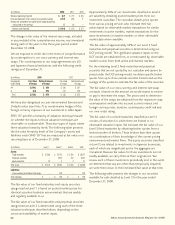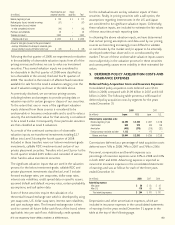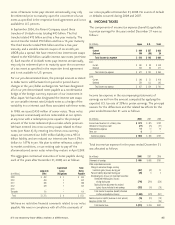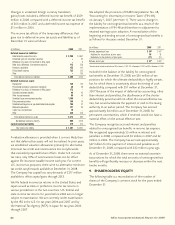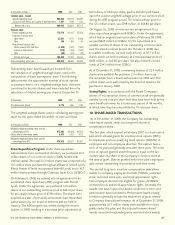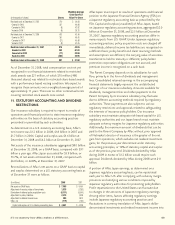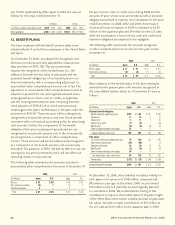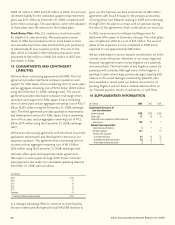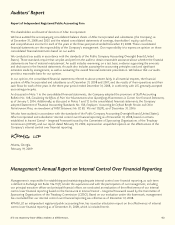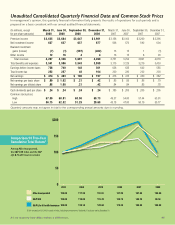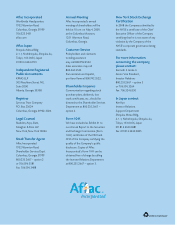Aflac 2008 Annual Report Download - page 95
Download and view the complete annual report
Please find page 95 of the 2008 Aflac annual report below. You can navigate through the pages in the report by either clicking on the pages listed below, or by using the keyword search tool below to find specific information within the annual report.
91
It’s no mystery how Aflac makes a difference.
The composition of plan assets as of December 31 was as
follows:
2008 2007
Japan U.S. Japan U.S.
Equity securities 30% 61% 36% 61%
Fixed-income securities 70 34 64 34
Cash and cash equivalents – 1 – 1
Other – 4 – 4
Total 100% 100% 100% 100%
Equity securities held by our U.S. plan included $3 million
(2.1% of plan assets) of Aflac Incorporated common stock
at December 31, 2008, compared with $4 million (2.5% of
plan assets) at December 31, 2007. Target asset allocations
for U.S. plan assets are 60% to 65% equity securities, 35%
to 40% fixed-income securities and 0% to 3% cash and cash
equivalents. Target asset allocations for Japanese plan assets
are 35% equity securities and 65% fixed-income securities. As
discussed below, the investment strategy of our pension plans
is long-term in nature.
The investment objective of our U.S. and Japanese plans is to
preserve the purchasing power of the plan’s assets and earn
a reasonable inflation adjusted rate of return over the long
term. Furthermore, we seek to accomplish these objectives
in a manner that allows for the adequate funding of plan
benefits and expenses. In order to achieve these objectives,
our goal is to maintain a conservative, well-diversified and
balanced portfolio of high-quality equity, fixed-income
and money market securities. As a part of our strategy, we
have established strict policies covering quality, type and
concentration of investment securities. For our U.S. plan,
these policies prohibit investments in precious metals, limited
partnerships, venture capital, and direct investments in real
estate. We are also prohibited from trading on margin. For
our Japanese plan, these policies include limitations on
investments in derivatives including futures, options and
swaps, and low-liquidity investments such as real estate,
venture capital investments, and privately issued securities.
We monitor the U.S. plan’s performance over a three- to five-
year period utilizing shorter time frame performance measures
to identify trends. We review investment performance and
compliance with stated investment policies and practices on
a quarterly basis. The specific investment objectives for the
U.S. pension plan are: to exceed a composite of asset class
target returns, weighted according to the plan’s target asset
allocation; and to outperform the median fund from a universe
of similarly managed corporate pension funds. Both objectives
are measured over a rolling three- to five-year period. We
monitor the Japanese plan’s asset allocation and compliance
with stated investment policies and practices. The Japanese
plan’s performance is reviewed on a quarterly basis by asset
allocation. The specific investment objective for the Japanese
plan is to outperform the projected long-term rate of return
used to determine the Japanese plan’s pension obligation.
Expected future benefit payments for the U.S. and Japanese
plans are as follows:
(In millions) Japan U.S.
2009 $ 4 $ 4
2010 5 5
2011 5 5
2012 6 6
2013 6 7
2014 - 2018 36 48
The components of retirement expense and actuarial
assumptions for the Japanese and U.S. pension plans for the
years ended December 31 were as follows:
2008 2007 2006
(In millions) Japan U.S. Japan U.S. Japan U.S.
Components of net periodic
benefit cost:
Service cost $ 11 $ 10 $ 9 $ 10 $ 8 $ 9
Interest cost 3 11 3 10 3 9
Expected return on
plan assets (2) (12) (2) (10) (1) (7)
Amortization of
net actuarial loss 2 2 1 4 2 3
Net periodic benefit cost $ 14 $ 11 $ 11 $ 14 $ 12 $ 14
Weighted-average actuarial assumptions
used in the calculations:
Discount rate – net periodic
benefit cost 2.50% 6.00% 2.50% 5.50% 2.50% 5.50%
Discount rate – benefit
obligations 2.50 6.25 2.50 6.00 2.50 5.50
Expected long-term return
on plan assets 2.50 8.00 2.50 8.00 2.50 8.00
Rate of compensation
increase N/A* 4.00 N/A* 4.00 N/A* 4.00
*Not applicable
In Japan, participant salary and future salary increases are not
factors in determining pension benefit cost or the related
pension benefit obligation.
We base the long-term rate of return on U.S. plan assets on
the historical rates of return over the last 15 years and the
expectation of similar returns over the long-term investment
goals and objectives of U.S. plan assets. We base the long-term
rate of return on the Japanese plan assets on the historical
rates of return over the last 10 years.
In addition to the benefit obligations for funded employee
plans, we also maintain unfunded supplemental retirement
plans for certain officers and beneficiaries. Retirement expense
for these unfunded supplemental plans was $11 million in



